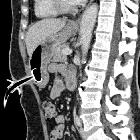Buried bumper syndrome


Buried bumper syndrome (BBS) is a rare but important complication in patients with a percutaneous gastrostomy tube, occurring by migration of the internal bumper along its track. The tube may get lodged anywhere between the gastric wall and the skin and lead to life-threatening complications including hemorrhage, peritonitis, hollow viscus perforation, abscess formation and necrosis.
Epidemiology
Reported incidence lies somewhere between 0.3-4% of patients. Most commonly seen as a late complication, it has been reported as early as 1 week after tube placement . Not surprisingly, the risk of buried bumper syndrome varies between various models/types.
Clinical presentation
Symptoms and signs may comprise
- simple PEG tube malfunction
- leakage from peristomal areas
- erythema and edema of the peristomal skin
- abdominal pain
- frank peritonitis
Pathology
Pathogenesis
The most accepted theory is that of high-grade tension between the external and internal plate, leading to necrosis of the gastric wall and allowing for wandering of the bumper along its track, where it can get lodged anywhere. Development of an epithelial covered channel may prevent overt tube malfunction and/or visualization of contrast leak by fluoroscopy (see below).
Important factors
Many risk factors have been identified, including
- reduced space between external bumper and skin
- obesity
- rapid weight gain
- frequent manipulation of the tube in early post insertion period
- frequent patient and tube manipulation, possibly by inexperienced personnel
- gauze placement beneath external bumper
- chronic cough
Obesity appears to stand out as the single most important factor .
Complications
range from malfunction to malnutrition, bleeding, peritonitis, abscess formation, necrosis including necrotizing soft-tissue infection and eventually death .
Radiographic features
Although the most sensitive test is considered to be endoscopy, allowing for both the diagnosis and possible treatment, also imaging studies play a pivotal role both in suggesting the diagnosis and depicting the degree of this potentially fatal complication.
Fluoroscopy
Although upper gastrointestinal studies may suggest pneumoperitoneum and/or contrast leak from the tube, there have been examples where they failed in diagnosing the entity, possibly attributable to development of an epithelisied channel.
Ultrasound
May allow for assessing the location of the internal bumper and depict local or peritoneal collections.
CT
Allows for accurate assessment of both the internal bumper´s location and potential additional findings .
Treatment and prognosis
Initially considered a surgical emergency, treatment choices now largely depend on patient state and range broadly. Surgery, endoscopic removal/replacement, local incision followed by replacement using the existing track or a new track, dependent of inflammatory changes .
Practical points
- maintaining a high level of clinical suspicion of this potentially life-threatening complication may be life-saving
- cross-sectional imaging should be pursued/offered readily by the radiologist, possibly even as first-line imaging
Siehe auch:

 Assoziationen und Differentialdiagnosen zu Buried bumper syndrome (BBS):
Assoziationen und Differentialdiagnosen zu Buried bumper syndrome (BBS):



